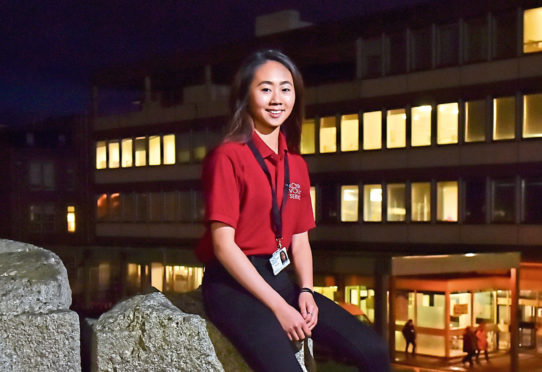At 17 years old, Tessa Yau is preparing to take school exams and has high hopes of becoming a doctor.
She wants to study medicine at university, but believes there is a lot more to succeeding at the job than science alone.
Indeed, she is already on her way to becoming a fantastic medic – with the belief that empathy and getting to know patients is the way forward.
The Albyn School pupil is one of the youngest volunteers with the Royal Voluntary Service (RVS) after she signed up for their on-ward initiative.
The role means Tessa, who lives in Kingswells, gives up her spare time to visit patients at Aberdeen Royal Infirmary (ARI).
In doing so, she has helped over-stretched staff and reassured lonely patients.
RVS commissioned a poll of 200 nurses working in acute hospitals in Britain, and discovered that 40% of patients do no get visitors.
It is believed that, alongside social isolation, having no visitor to help with practical tasks, such as cutting up food, can delay recovery.
Although hospital volunteers are no substitute for medical staff, they are able to chat to patients when nurses are too busy.
And despite the fact that there are often many years’ difference in age between Tessa and the patients she visits, conversation is rarely lacking.
“I started volunteering in April after I applied last summer,” said Tessa.
“Now I go every Sunday and it’s something I always look forward to.
“I love visiting the female ward in particular, you often have the chance to get to know patients quite well.
“This is because elderly patients in particular can be on the ward for several weeks at a time, and sometimes longer.
“The nurses normally tell me which patient might appreciate a chat.
“Or they’ll point out someone who has been feeling a bit low.
“I think it’s a real privilege to try to uplift that person’s spirits.”
Tessa has become a firm favourite with some of the patients she visits, and has even found herself in demand.
“Sometimes you can tell if a patient wants to chat because they give me a huge smile as soon as I come in the ward,” she said.
“Or they’ll say ‘see you next time’, so I know they want me to visit again.
“Conversations can last from 10 minutes to an hour, it really depends what we’re talking about.
“I think people my age don’t often get the chance to talk to the older generation.
“But we always find something to discuss, and I’ve had some really interesting conversations.”
The on-ward service has 40 volunteers spread out across seven wards at ARI – and the scheme has been running for seven years.
A quick chat with a volunteer can provide much-needed stimulation, and help break up a patient’s day.
All volunteers are trained by an NHS dietician, and can help encourage patients to eat and drink.
Be it helping a patient to fill out a meal card, or fetching a fresh jug of water, volunteers can clearly make a huge difference.
All volunteers undergo thorough training before going out on to the wards and complete a module called “understanding dementia”.
“Sometimes patients don’t want to talk, and that’s perfectly understandable,” said Tessa.
“I think the secret to getting the conversation flowing is to find something we both have in common.
“I used to think that might be difficult, but it has been surprisingly easy.
“Some patients are really eager for the conversation, and I love seeing what a huge difference it can make.
“It’s very rewarding.
“I was quite nervous when I came on to the ward for the first time, but I quickly got used to things.
“I want to study medicine at university, and I think volunteering has helped me understand how patients are feeling.
“Speaking to patients enables you to understand them more, and that means you can be more empathetic.
“I think that’s really important.
“I’ve struck up friendships during my time on the wards, and I often find myself really missing patients once they’ve gone home.”
RVS volunteers can provide help in all sorts of ways. They offer practical help and companionship, deliver books to those who love reading but can’t get to their local library, and drive people who can’t get out and about to the GP or hospital appointments, shopping trips and to local social events and activities. They run clubs and groups in communities where older people can socialise and enjoy something to eat and drink. They provide exercise classes, activities and companionship for older people in hospital, and support their return home. They also run hospital welcome desks and more than 230 hospital shops, cafes and trolley services.
How you can help
The on-ward service is just one of the four services in Aberdeen focused on supporting vulnerable older people in the hospital or community. Volunteers can also get involved with the home from hospital scheme. Once a patient has been discharged, they often require further support such as transport to follow-up appointments or rehab classes. If you enjoy driving and meeting people, RVS would like to hear from you.
For more information, visit royalvoluntaryservice.org.uk
